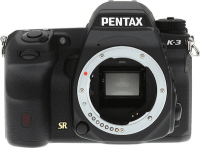Pentax K-3 First Shots posted: Pixel peep revolutionary DSLR’s test images with AA filter on and off
posted Tuesday, October 29, 2013 at 12:17 PM EST

Our first impressions Pentax K-3 review generated a lot of interest from IR readers, so we were eager to post the IR Lab's First Shots taken with the camera as soon as we received the final firmware. The K-3 marks a big step up for Pentax's flagship APS-C DSLR, featuring significant changes inside and out -- most notably an industry first: On-demand, optical low-pass (anti-aliasing) filtering which lets you choose whether ultimate resolution or resistance to moiré are more important for any given shot.
The 24.3-megapixel Pentax K-3 packs 50% more pixels into its APS-C sized image sensor than the K-5 II, increasing linear resolution by almost a quarter. And thanks to a new PRIME III image processor, it simultaneously increases performance to a whopping 8.3 frames per second at full resolution, for as many as 60 JPEG or 23 RAW frames. And despite the significant resolution increase, the K-3 still offers a maximum sensitivity of ISO 51,200 equivalent.
So how do these upgrades translate to image quality? Take a pixel peep at these First Shots -- Still Life* images taken with the OLPF/AA filter turned off, and Multi Target* images taken with the OLPF/AA filter both off and on (at two different levels) -- and we're certain you're going to be intrigued by what this camera can do. Using our Comparometer™, you can also pit sample pictures taken with the K-3 side-by-side against those from the K-5 II, K-5 IIs or any other camera we've ever tested. Go check out the images, then circle back and let us know what you think about the K-3's image quality.
See First Shots taken with the Pentax K-3 here. And be sure to read our first impressions Pentax K-3 review for a closer look at the camera's new features. Don't miss our Geek's Guide that explains in detail the K-3's revolutionary, switchable OLPF/AA-filter technology. Stay tuned in the coming weeks for our complete Pentax K-3 review!
* Use our Still Life target images to look for detail (tone-on-tone, fine, highlights, shadows), as well as noise suppression, white balance, color accuracy and color shape retention. Use the Multi Target images to look for color handling, contrast vs. detail vs. noise, and moiré. Both targets are shot at the full range of ISOs to show how many of these factors change as ISO rises. In this instance, if you compare the USAF Resolution and Color Starburst targets in our K3hVFA_AA[2..0] Multi Target series, you can see the progressively stronger blurring that higher AA settings add, along with reduced color moiré at higher frequencies in the Log C/F target.